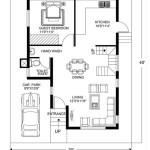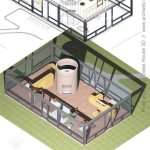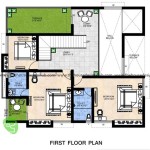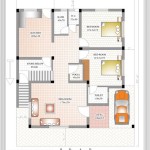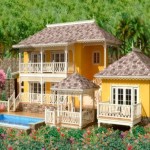Single-Story House Plans with Dual Master Suites: Considerations and Design Principles
The concept of a single-story house plan incorporating dual master suites is gaining traction in contemporary residential architecture. This design addresses diverse lifestyle needs, accommodating multigenerational living, providing independent spaces for roommates, or offering enhanced guest accommodations. This article examines the key considerations and design principles crucial for successfully implementing dual master suites within a single-story home.
A master suite, conventionally, is a larger bedroom designed for optimal comfort and privacy, typically including an attached bathroom and walk-in closet. In a dual master suite configuration, a dwelling features two such independent suites, each offering comparable amenities and spatial qualities. The design considerations for such a home extend beyond merely duplicating a standard master suite; careful planning must account for overall layout, privacy, accessibility, and integration with the rest of the house.
Optimizing Layout and Spatial Relationships
Strategic layout is paramount in single-story homes with dual master suites. The placement of these suites significantly influences the overall flow and functionality of the residence. Several layout options exist, each with its own advantages and drawbacks. One common approach is to position the master suites on opposite ends of the house, effectively creating separate wings. This arrangement maximizes privacy and minimizes potential noise transfer between the suites. A central living area, including the kitchen, dining room, and common living space, then serves as a buffer zone.
Another approach involves flanking the central living area with the two master suites. This design can be particularly suitable for smaller footprints, allowing for easier access to shared spaces. However, it necessitates careful attention to soundproofing and privacy measures. The use of strategically placed hallways, closets, or even secondary rooms can help to mitigate noise and create a sense of separation between the suites. Consider also that the aspect and orientation for both Master bedrooms are same or different. This will effect what activities might be done in each space.
Regardless of the layout chosen, the orientation of the house on the lot should be carefully considered. Optimizing natural light and views for both master suites is essential. The placement of windows and doors should be planned to maximize natural light while maintaining privacy. The use of landscaping can further enhance privacy and create a visual buffer between the suites and neighboring properties.
Within the master suites themselves, the layout should prioritize functionality and comfort. Adequate space should be allocated for the bedroom area, bathroom, and walk-in closet. The bathroom design should consider accessibility and incorporate features such as grab bars and wider doorways if necessary. The walk-in closet should be efficiently organized to maximize storage space and minimize clutter. The shape and dimension of the room is affected by the location and orientation of the walls. The angle and wall length will determine the room dynamics and how effective it can be used.
Prioritizing Privacy and Sound Control
Privacy is a crucial element in any home, but it becomes even more critical when incorporating dual master suites. The goal is to create independent living spaces that offer a sense of seclusion and tranquility for each occupant. Effective sound control plays a vital role in achieving this goal. Several strategies can be employed to minimize noise transfer between the suites and other areas of the house.
One of the most effective methods for soundproofing is to use high-quality insulation in the walls, floors, and ceilings. Dense materials such as rock wool or fiberglass insulation can significantly reduce the transmission of sound waves. The use of double-pane windows and solid-core doors can further enhance sound control. These features help to block out external noise and prevent sound from traveling between rooms. The location of interior walls is important to consider. A shared wall means more sound transfer unless noise dampening materials are used. A hallway or closet space that separates the master bedroom suites gives separation from the sounds.
In addition to physical barriers, the layout of the house can also contribute to privacy. As mentioned earlier, positioning the master suites on opposite ends of the house or flanking them with buffer zones can help to minimize noise transfer. Strategically placed closets, bathrooms, or hallways can also serve as sound barriers. Furthermore, the use of soft materials such as carpets, rugs, and curtains can help to absorb sound and reduce reverberation.
Privacy extends beyond sound control; visual privacy is equally important. The placement of windows and doors should be carefully considered to prevent unwanted views into the master suites. The use of blinds, shades, or curtains can provide additional privacy as needed. Landscaping can also play a role in creating a visual buffer between the suites and neighboring properties. Strategic placement of trees and shrubs can help to block unwanted views and create a sense of seclusion. Thoughtful planning on the placement of trees will allow for proper sunlight and prevent branches from becoming too close to the exterior of the house. Make sure to note future growth and maturity of any plant that is planted.
Addressing Accessibility and Universal Design Principles
When designing single-story house plans with dual master suites, it is crucial to consider accessibility and universal design principles. These principles aim to create homes that are usable by people of all ages and abilities, regardless of their physical limitations. Incorporating accessibility features not only benefits those with disabilities but also enhances the overall comfort and convenience of the home for everyone.
One of the most important accessibility considerations is the provision of wider doorways and hallways. Doorways should be at least 36 inches wide to accommodate wheelchairs and walkers. Hallways should be at least 42 inches wide to allow for easy maneuvering. The use of lever-style door handles is also recommended, as they are easier to operate for people with limited hand strength.
In the bathrooms, accessibility features such as grab bars, roll-in showers, and comfort-height toilets should be incorporated. Grab bars should be securely mounted in the shower and toilet areas to provide support and stability. Roll-in showers eliminate the need to step over a threshold, making them accessible to people who use wheelchairs or have difficulty walking. Comfort-height toilets are taller than standard toilets, making them easier to sit on and stand up from.
In the kitchen, adjustable-height countertops and appliances can enhance accessibility for people of different heights. Pull-out shelves and drawers can also make it easier to reach items stored in cabinets. The placement of light switches and outlets should be carefully considered to ensure that they are easily accessible to everyone.
Beyond these specific features, universal design principles should be applied throughout the home. This includes providing adequate lighting, minimizing tripping hazards, and using easy-to-operate hardware. The goal is to create a home that is safe, comfortable, and convenient for everyone, regardless of their abilities. Ramps, instead of steps, can be incorporated into entrances. Wider hallways, with more turning radius allow for easier movement from room to room.
Incorporating dual master suites into a single-story home requires careful consideration of layout, privacy, and accessibility. By prioritizing these design principles, it is possible to create a comfortable, functional, and aesthetically pleasing living space that meets the diverse needs of its occupants. Careful planning in the early stages of the design process can help to minimize potential challenges and ensure a successful outcome.
Ultimately, the most effective design for a single-story home with dual master suites is one that is tailored to the specific needs and preferences of the homeowners. Collaborating with a qualified architect or designer can help to translate these needs into a functional and beautiful living space. They are useful in recommending the proper materials and designs to fit the needs of the home and owners. They can take budget concerns and desired design elements to create a unique home.

Plan 69691am One Story House With Two Master Suites Plans New 2 Bedroom

Exclusive One Story Craftsman House Plan With Two Master Suites 790001glv Architectural Designs Plans

House Plans With Two Master Suites One Story Google Search Level Basement

Dual Master Suites 17647lv Architectural Designs House Plans

House Plans With Two Master Suites Dfd Blog

Cottage Dual Master Suites Logcabinhouseplans Logcabinhomes Smallhouseplans Housef Suite Floor Plan Craftsman Style House Plans Bedroom

Dual Owner S Suite Home Plans By Design Basics

House Plans With Two Master Suites Dfd Blog

1 Story House Plans With 3 Master Suites And A Courtyard

Pin On House Plans

